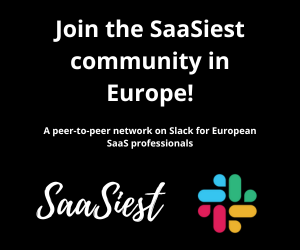Today, we are more global than ever before. Our purchasing behavior is also more similar than it’s ever been. So does that mean that we can approach our audiences with the same message, in the same language, and in the same way? In this fireside chat with moderator Trine Grönlund, Susanne Rönnqvist Ahmadi, VP of International Marketing for Hubspot, weighed in with her experiences and insights about growing Hobspot’s international presence over the past several years.
Takeaways
- Changes in technology (like the Google algorithm and the rise of AI) are changing behavior patterns, affecting inbound and outbound.
- Our ability as marketers to capture market share is shrinking and it’s declining faster in non-English markets.
- The most successful companies are integrating inbound and outbound.
- If you don’t use AI now, and if this is not keeping you up every day, you’re going to fall behind very, very fast.
- Know your customer, and put your customer first in everything you do. That’s all that matters.
Hubspot came up with the term inbound marketing. You mentioned that things are changing with inbound marketing, and we can’t look at it the same way anymore. Can you elaborate on that?
When I joined HubSpot, the intention was to increase Hubspot’s global presence and make it a more globally relevant company. So I started looking at different models for going international. I was obsessing over the growth of our website and our blogs, which are huge with more than 150 million visitors in a year. Then one day, Google changed its algorithm, and site visitors dropped massively across the world. I started seeing global patterns that I hadn’t seen before.
The internet is changing significantly. When this drop in traffic happened at Hubspot, we knew we were still ranking high on search engine result pages, but we weren’t getting traffic to our site. We weren’t getting the conversions that we’d seen historically. We’ve seen that inbound is changing, too. All of you have a total addressable market with billions of potential. But our ability as marketers to capture that is decreasing. And it’s going fast and manifesting faster in non-English markets like Sweden. I’m seeing patterns that mean our ability to win in the way we have over the last several years is changing.
Instead, we are seeing disruption. AI is one example, but also how Google is now monetizing the visitors to their sites is becoming a massive challenge for us as marketers. Unless you can capture the folks that are browsing your site and your blog, inbound is becoming a very different motion from what it used to be.
It means that as marketers going international, you need to look at the total addressable market, take the inbound portion, and realize that it is shrinking. As a marketer, you have to own the narrative to your CEO as to why marketing performance is down and what else you need to do next to continue to expand globally at the same pace.
The same reason inbound is being disrupted by AI is that search is changing. We are behaving differently online. Outbound and our ability to more intentionally reach folks without them coming to us is also being disrupted for the same reasons.
At Hubspot, we’ve done a lot of surveys leveraging our customer base of close to 200.000 customers. We’re seeing that the most successful sales teams and companies are the ones that integrate inbound with outbound and do that with real intent leveraging technology, like AI. If you don’t use AI now, and if this is not keeping you up every day, you’re going to fall behind very, very fast.
So if I’m a marketer and I want to go international, how should I think about these new changes to technology and buying behavior?
The number one thing you have to remember when going into any market is you have to know your customer. What conferences do they go to? Where are they networking and building knowledge? Where do they search for information? Where are they identifying tools like those you provide?
As marketers and leaders who own global expansion, we tend to look at incredibly large markets, and think, I want to go after it because it’s the biggest one. But if you don’t know your buyers there, it may be extremely hard to monetize the market and have a chance of winning. You also have to blend in brand, which is really important. It’s not about disrupting as a one-off activity and waiting for the results to come in. As a CEO, you have to be brave enough to invest in the brand because it’s not going to give you a return on investment as quickly as if you do a direct campaign with a direct response.
You represent one of the largest SaaS companies in the world. Is this approach true for smaller companies too?
Yes. The first question I always get, even with small and mid-sized companies I advise, is what’s the language I should go for first? My advice is always, Who are you targeting? Are they advanced enough to have their business conversations in English? Fine. Go for English. But if you’re selling a product or a tool or a solution to a target group that doesn’t speak English, then go for the local language. It’s really about knowing your market, understanding that country, understanding your buying persona, and then building your strategy based on that.
Don’t think too much about your internal processes. It’s very easy to think about AI as an example of how to be smarter about how you work at your company. But think about AI as a way to obsess over your customer experience. How can I make it easier for my potential customer to buy from me? That’s a core shift and a mindset change we need to have. We need to rethink how we obsess over our customers. If you align all vectors to your customer and you wrap everything around your customer, you have 10 times more probability to win.
Do you think that these new challenges and this new era will make us more innovative? Or will it just be harder overall to accomplish it?
It’s going to be easier to be creative with the new tools. With AI, we can test hypotheses and ideas and figure out different options in no time. If you don’t live and breathe and understand the new technology, you’re going to fall behind very fast. But you have to put the customer experience first, then your internal processes next.
Could focusing on the customer help marketers navigate all these changes in a sustainable way?
You need to constantly be developing yourself. Having that hunger, that growth mindset, and the ability to constantly learn new things is the only way to keep up with the pace. The speed of change (for example, how quickly ChatGPT was adopted) is going to disrupt everything for marketers. The best thing for marketers to do is to embrace it. If you’re a marketer today and you go into a meeting and AI and optimizing for your customer is not part of the agenda, it’s like saying, I don’t need a computer to do this. Everyone is a digital marketer, and everything is built on a digital concept. The point of gravity will have to be more customer-centric.
What are three takeaways we want everyone to walk away with from this conversation?
Put your customer first. That’s all that matters.
Inbound is evolving. It needs to include more outbound and prospecting blended with a strong brand presence.
You have to focus on outcomes and quality, not just volume. Build high intent and value in all things you do, and you’ll be a successful marketer.
Don’t push your products. It’s all about helping humans, and the human is your customer. Helping them will help your company, and the revenue will come.




